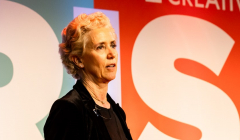
Diageo CMO on progressive media, AI and inclusivity
Speaking at the Creative Equals Rise conference, Cristina Diezhandino, Chief Marketing Officer at Diageo, lifted the lid on the brand's progressive marketing journey

RNIB and The&Partnership have launched a pop-up store highlighting the inaccessibility of shopping.

Imagine walking into a shop to find that all of the products are un-labelled. No nutritional information, no allergen warnings, no way of knowing what’s inside each item. This is the shopping experience that many blind or partially sighted people face every single day.
To raise awareness of how inaccessible the shopping experience can be, Royal National Institute of Blind People (RNIB) and The&Partnership opened a pop-up store to highlight this very issue. By bringing to life inaccessible packaging, the pop-up showed the impact that inaccessible shopping can have by allowing visitors to experience what it’s like for people with sight loss.
As part of their ongoing “Design for Everyone” campaign, the pop-up named, ‘Whatsin Store’ looked every inch like a normal corner shop except the fact that it was stocked with deliberately inaccessible packaging. From intentionally vague branding designed by The&Partnership, to items entirely removed of information, shoppers were presented with an array of products impossible to decipher.
Within the pop-up, hidden cameras filmed people’s reactions to being confronted with such an inaccessible store; most of which were understandably extremely frustrated. The shopkeeper then went on to reveal that this is a common reality for people with sight loss when they are out shopping or want to buy food on the go.
“Everyone has the right to know what they’re buying yet packaging information is so often inaccessible for blind and partially sighted people. Our research shows that almost three-quarters of people feel that accessing product information on food packaging is very important to them. Yet 9 in 10 said that packaging is difficult or impossible to read.” Matt Stringer, CEO, RNIB explained.
“People told us they often rely on their memory for locating products or felt forced to ask for help. They shouldn’t have to rely on friends, family or shopworkers to buy food. It’s a matter of choice and of independence.” Stringer continued. “RNIB is campaigning for products and services to be reimagined with accessibility in mind, because when products are designed for anyone, the result is better for everyone.”
The&Partnership designed bespoke products as part of the campaign which featured vague packaging to highlight specific issues. For example, the ‘Can’t guarantee it’s not gluten’ biscuits by ‘Unhappy Shopper’ demonstrate the serious issue blind and partially sighted people with Coeliac disease have. For these shoppers, knowing if a product contains gluten is crucial but often impossible due to inaccessible packaging.
The campaign follows the groundbreaking move by the RNIB and The&Partnership to open-source their plans for a pregnancy test for people who are blind.
“Tackling the issue of inaccessible design is an ongoing mission for both us and RNIB.” said Yan Elliott, Joint Executive Creative Director at The&Partnership, “Our most recent ‘Design for Everyone’ campaign highlighted the lack of privacy caused by inaccessible pregnancy tests. In this next iteration of the campaign, we are literally bringing to life the issues blind and partially sighted people face just doing the weekly shop. We hope the campaign encourages businesses to work with RNIB to find solutions for their products as there are many technologies and tools out there that can help make packaging accessible for everyone.”
RNIB and The&Partnership have created a series of films using the footage from the pop-up store, made with award-winning director Jonty Toosey, which will be live across RNIB’s social channels and website, The film, made accessible via audio description, shows members of the public shopping in the “Whatsin Store” and their subsequent confusion and frustration.
Planned and executed by Wavemaker and Kinetic WW, the store dramatizes the challenge faced by blind and partially-sighted people and in doing so, hopes to spark the motivation to act. Accompanying imagery, films and editorial will amplify the message and give supporters and decision-makers the information to ‘Design for Everyone’, in the hopes to move toward a more inclusive future of packaging.
At a time in which brands and retailers alike are fundamentally reaprraising the role of physical retail space this campaign is a powerful reminder of the opportunity not just build back better post pandemic, but build back for everyone.
Looks like you need to create a Creativebrief account to perform this action.
Create account Sign inLooks like you need to create a Creativebrief account to perform this action.
Create account Sign in